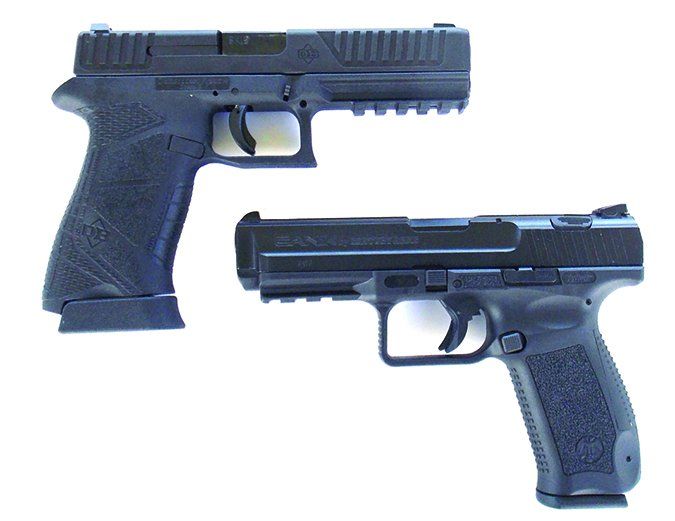
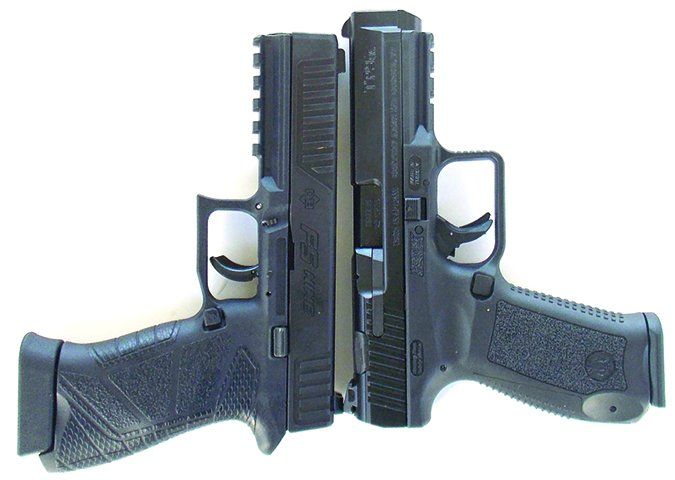
The high-capacity 9mm handgun continues to be a popular personal-defense choice, for good reason. Many of the finest handguns in the world are chambered for the 9mm Luger cartridge and nothing else. In a handgun of 30 ounces or so, loaded recoil is light to manageable. Practical accuracy may be outstanding. A magazine capacity of 15 rounds or more is reassuring and gives a good reserve of ammunition. With these considerations in mind, we tested two modern economy-grade 9mm handguns whose performance was acceptable, especially considering the price, though our shooters found we liked one pistol better.. These two handguns are large for concealed carry, but they are light enough and may be concealed with enough effort and an intelligent holster choice. Certainly, they can be employed in the home, where overall size is less of an issue. Those firing and using compact handguns may not realize how easy bigger handguns are to use well compared to a pocket model.
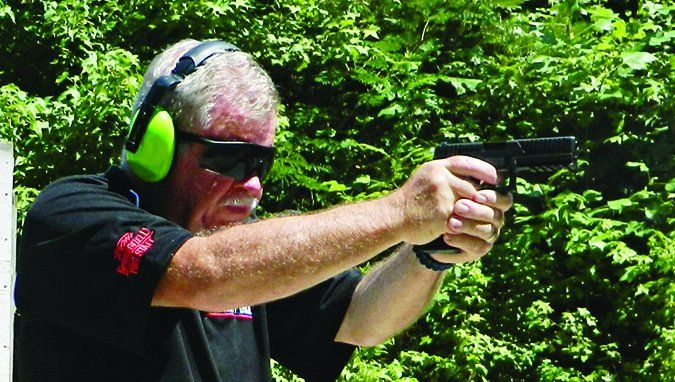
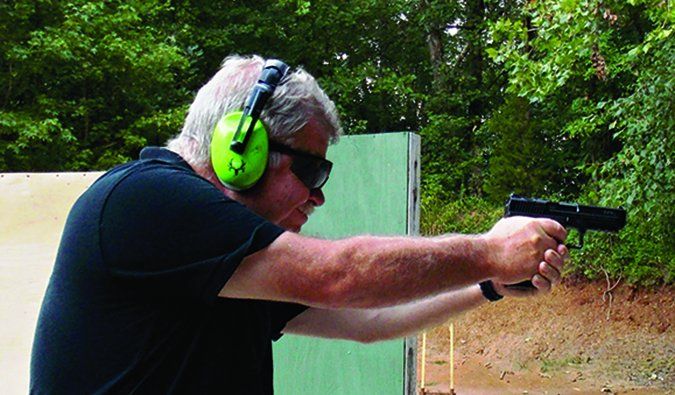
One such larger handgun that is affordable to boot is the Century Arms TP9SA, which is listed in the company’s catalog as SKU HG3277-N. A similar desert tan model is HG3277D-N. We found one selling for $346 at Budsgunshop.com and another one on sale at Cabela’s for just under $300. This handgun is manufactured by Samsun Yurt Savunma, a Turkish gun maker, and imported by Century Arms of Delray Beach, Florida. The TP9SA and many of its accessories are marked “Canik,” for the Canik 55 division of the manufacturer. So, to be plain about it, the Century Arms TP9SA is a Canik 55 9mm pistol, similar in outline to the Smith & Wesson SW99 and Walther P99. There are enough differences between the Canik and the Walther pistol to say the former is not a clone of the latter, but the Century import is obviously similar to a comparable Walther, being a service-size 9mm with a polymer frame and mid-length slide and a 4.25-inch barrel. Our second test gun was the Diamondback Firearms DB FS Nine DB9FS 9mm Luger, which lists for $483, but which we found at Budsgunshop.com selling for $265. Founded in 2009, Diamondback Firearms is based in Cocoa, Florida.
The Diamondback DB9FS is a striker-fired polymer-frame pistol that in general outline resembles the Glock 17. Our shooters noted that the pistol feels different than a Glock, and the overall configuration is markedly different than the Glock. Here’s more about these two affordable 9mm pistols:
| RANGE DATA | ||
| Black Hills Ammunition EXP 115-gr. Jacketed Hollow Point | Century Arms TP9SA | Diamondback DB9FS |
| Average Velocity | 1240 fps | 1201 fps |
| Muzzle Energy | 392 ft.-lbs. | 368 ft.-lbs. |
| Smallest group | 2.1 in. | 2.5 in. |
| Largest group | 2.5 in. | 3 in. |
| Average group size at 25 yards | 2.3 in. | 2.8 in. |
| Fiocchi Ammunition 124-gr. JHP SJHP 9APBHP | Century Arms TP9SA | Diamondback DB9FS |
| Average Velocity | 1121 fps | 1099 fps |
| Muzzle Energy | 345 ft.-lbs. | 332 ft.-lbs. |
| Smallest group | 2.2 in. | 2.6 in. |
| Largest group | 2.6 in. | 3 in. |
| Average group size at 25 yards | 2.4 in. | 2.8 in. |
| Winchester PDX1 Defender +P 124-gr. Bonded Jacketed HP | Century Arms TP9SA | Diamondback DB9FS |
| Average Velocity | 1226 fps | 1198 fps |
| Muzzle Energy | 413 ft.-lbs. | 395 ft.-lbs. |
| Smallest group | 2 in. | 2.8 in. |
| Largest group | 2.4 in. | 3.4 in. |
| Average group size at 25 yards | 2.3 in. | 3.2 in. |
| To collect accuracy data, we fired five-shot groups off a solid bench rest. We recorded velocity with a Shooting Chrony Master Chronograph, with the first skyscreen set 10 feet from the muzzle. Tested ammunition was from MidwayUSA.com: Black Hills Ammunition 115-grain EXP cost $14.57/20; Fiocchi 124-grain semi-jacketed hollowpoint rounds were $17/50; and Winchester 124-grain PDX1 +P cartridges were $22/20. | ||
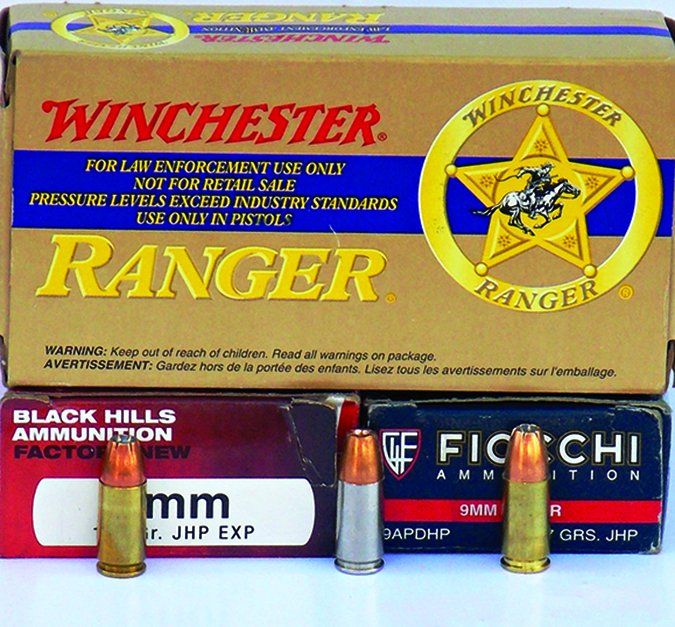
Century Arms TP9SA HG3277-N 9mm Luger, $346
GUN TESTS GRADE: A-
It was reliable, and the trigger action was the better of the two guns tested. We would have liked better accuracy.
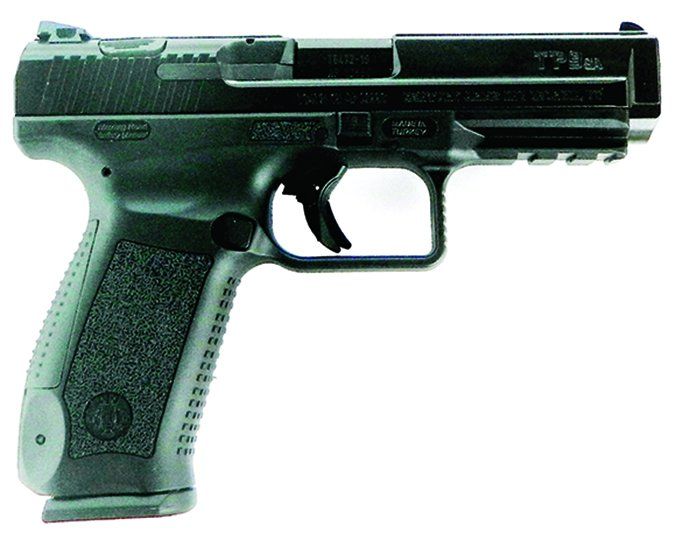
| ACTION | Semi-Auto, Locked breech single action |
| OVERALL LENGTH | 7.55 in. |
| OVERALL HEIGHT | 5.7 in. |
| MAX WIDTH | 1.3 in. |
| WEIGHT UNLOADED | 28 oz. |
| WEIGHT LOADED | 33.2 oz. |
| BARREL | 4.5 in. long; Hammer-forged steel |
| MAGAZINE | (2) 18-round detachable box |
| SLIDE | Steel; front/rear cocking serrations |
| FRAME | Polymer; Rev. magazine catch; M1913 rail |
| FRAME FRONT STRAP HEIGHT | 2.75 in. |
| FRAME BACK STRAP HEIGHT | ~3.65 in., 2 interchangeable straps |
| GRIPS | Textured grip frame |
| GRIP THICKNESS | 1.25 in. |
| GRIP CIRCUMFERENCE | 5.6 in. |
| SIGHTS | 3-dot steel |
| TRIGGER PULL WEIGHT, SINGLE ACTION | 5.5 lbs. |
| TRIGGER SPAN SINGLE ACTION | 2.75 in. |
| SAFETY | Firing pin block, trigger lever |
| DECOCKER | Ambi slide mounted |
| LOADED CHAMBER INDICATOR | Yes |
| COCKING INDICATOR | Yes |
| WARRANTY | Limited lifetime |
| TELEPHONE | (800) 527-1252 |
| WEBSITE | CenturyArms.com |
| MADE IN | Turkey |
| IMPORTED BY | Century Arms, Delray Beach, FL |
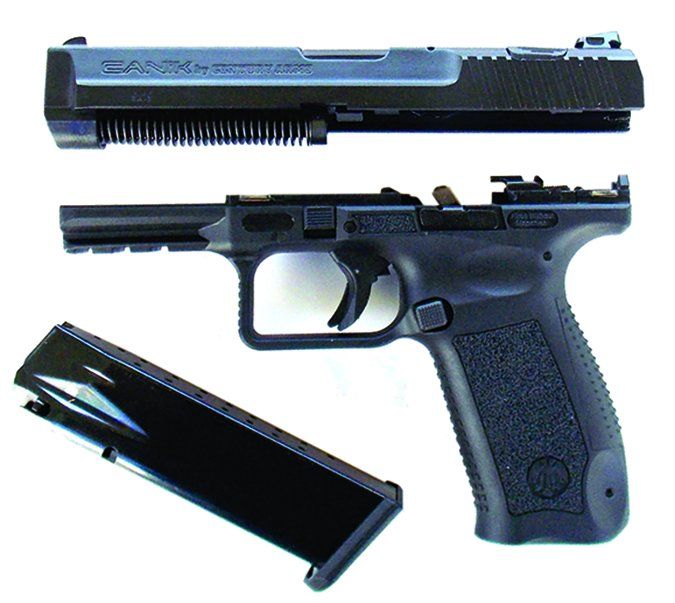
Upon first examination, we saw the slide was well machined, with no tool marks, and the bevels and machining looked good. Barrel-to-slide fit was acceptable. The barrel hood locked into the ejection port in the SIG/Glock fashion. The cocking serrations on the slide allowed adequate purchase for manipulation. There is a loaded-chamber indicator that rises when the chamber is loaded. To our shooters, the sights seemed small for this type of handgun, but they nonetheless offered an adequate sight picture. The sights displayed a three-dot configuration, along with a white bar on the rear sight in the seldom-seen bar-dot configuration. When cocked, the striker protruded in a witness hole in the rear of the slide. The end of the striker is a visible red color.
We liked the slide-lock design. It wasn’t difficult to manipulate, but on the other hand it seemed unlikely to be actuated inadvertently. It was ergonomic, and even raters with short fingers had no difficulty operating the slide lock. There were finger reliefs on each side of the trigger guard to lessen the trigger span. The front strap and rear strap featured raised protrusions to aid grip. The sides of the handle were also roughened. While offering good adhesion, none of these surfaces were uncomfortable when firing, we learned.
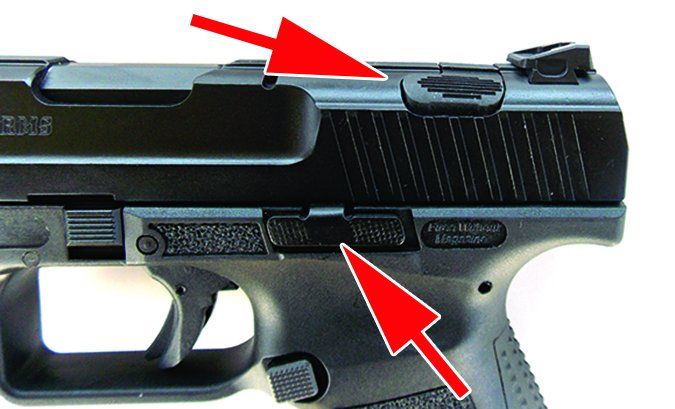
It was possible to change the rear strap by removing a pin at the bottom of the grip strap. The grip was large, but fit the raters’ hands well. The magazine featured 17 staggered witness holes and held 18 rounds of ammunition. The magazine was not difficult to load to full capacity, although greater effort was needed with the final cartridges. The magazine release was a Browning type with a flat button. We did not like the fact that it isn’t protected from activation by a border of some type, but we experienced no problems with it during the firing test.
The pistol field-strips more easily than most, with two comfortable spring-loaded levers under the ejection port. We liked this system better than the Glock type used with the Diamondback. The recoil-spring guide was plastic, and the recoil spring seemed strong enough. The frame featured a rail for mounting a combat light or other accessory.
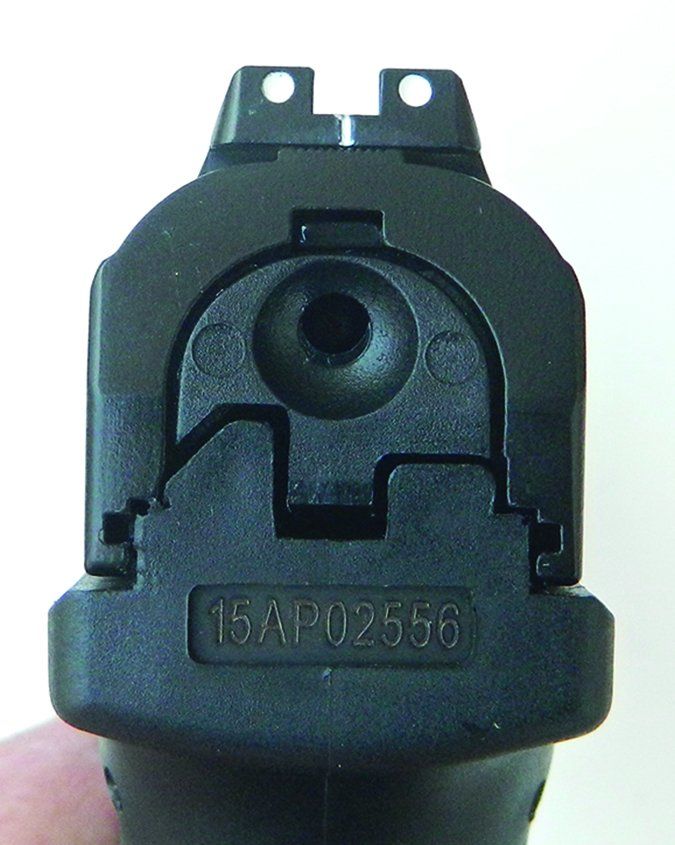
Now to the action. The earlier TP9 is a double-action first-shot handgun. The TP9SA, as the name suggests, is a single-action handgun, like the Springfield XD. To operate, the slide is racked, cocking the striker. There is a firing-pin block and a lever set in the trigger to prevent lateral or dropped gun discharges. The TP9SA’s trigger breaks at 5.5 pounds but with considerable take up. If you keep your finger on the trigger, you need not run through the take up again during firing strings because the trigger reset is short and rapid.
The conversion to single-action fire brings about an odd feature. The decocker of the double-action TP9 is retained, and it decocks the TP9’s double-action-first-shot trigger. With the TP9SA, the action is decocked with a cartridge in the chamber. The chamber is loaded, but the slide must be racked to reset the striker. We filled the primer pocket of a dummy training cartridge and decocked the piece with the training round chambered and found the pistol did not fire. We feel that this feature has little merit, save to decock the piece for storage.
The TP9SA was supplied with a Serpa-type plastic belt holster. Both belt- and paddle-holster attachments were supplied. While not Blackhawk quality, we found the Canik-marked holster to be superior to many other plastic holsters. In particular, it served well as a range holster, with good retention because the draw required the holster’s latch to be actuated on each draw.
The pistol was lubricated and prepared for the initial combat-firing stage. In initial firing, we used Winchester 147-grain Train & Defend FMJ loads ($13.47/50 from AmmunitionDepot.com) and Fiocchi 124-grain semi-jacketed hollowpoints.

One of the raters also supplied a box of Winchester Rangers, marked LEO-only but often available at gun shows. At the range, the TP9SA’s handle offered good purchase when drawing the pistol. Initial work was done engaging human-silhouette targets at 5, 7, and 10 yards. During firing, the pistol seemed slide heavy. This isn’t uncommon with polymer-frame handguns. The TP9SA never failed to feed, chamber, fire, or eject with 50 rounds of Winchester 147-grain 9mm and 40 rounds of Fiocchi 124-grain Extrema. Once we learned how to drive the slide up for the proper sight picture, hits were nicely centered. However, the pistol did not like 147-grain loads. With bullets traveling at 950 fps, the slide seemed to hang at the end of its travel, and we expected — but did not see — a short cycle.

0)]
Moving to accuracy testing, we used the Fiocchi load, the Winchester 124-grain +P load, and the Black Hills 115-grain EXP, a jacketed hollowpoint that’s not rated +P. Accuracy was acceptable, but we wanted more light in the sight picture. The best group at 2.0 inches was fired with the Winchester 124 grain +P. Three inches at 25 yards is deemed adequate for service use, so the TP9SA is adequate.
Our Team Said: Eye appeal and hand fit will sway the potential customer at the counter, and at the range, our test pistol was reliable. Also, the trigger allowed good control. The slide-lock position is ideal for a combat gun, and we liked the takedown manual of arms. The decocker is questionable, but it hurts nothing. The sights are adequate. Our worry about the magazine release’s exposure resolved itself when a rater wore the pistol extensively in a Falco IWB, and it stayed put. This pistol is yet another entry in the crowded polymer-frame 9mm field, and we think it offers a lot for the money.
Diamondback FirearmsDB FS Nine 9mm Luger, $265
GUN TESTS GRADE: B-
Attention to detail was lacking, in our view. The sights were not well regulated from the factory. We fixed that, but suffered a short cycle that we did not experience with the other pistol. Accuracy was poor. The magazines were difficult to load.

1)]
| ACTION | Semi-auto; locked breech single action |
| OVERALL LENGTH | 7.8 in. |
| OVERALL HEIGHT | 5.6 in. |
| MAX WIDTH | 1.25 in. |
| WEIGHT UNLOADED | 21.5 oz. |
| WEIGHT LOADED | 26.5 oz. |
| MAGAZINE | (2) 15-round detachable box |
| BARREL | 4.75 in. long; melonited chromely steel |
| SLIDE | Stainless steel, front and rear |
| FRAME | Polymer; double stack w/ 1913 rail dust cover |
| FRAME FRONT STRAP HEIGHT | 2.5 in. |
| FRAME BACK STRAP HEIGHT | 3.6 in. |
| GRIPS | N/A |
| GRIP THICKNESS | 1.25 in. |
| GRIP CIRCUMFERENCE | 5.6 in. |
| SIGHTS | Steel; fixed 3-dot |
| TRIGGER PULL WEIGHT | 6.5 lbs. |
| TRIGGER SPAN | 2.75 in. |
| SAFETY | Firing pin lock; trigger lever |
| LOADED CHAMBER INDICATOR | Yes |
| COCKING INDICATOR | Yes |
| WARRANTY | Limited lifetime |
| TELEPHONE | (877) 997-6774 |
| WEBSITE | DiamondbackFirearms.com |
| MADE IN | USA |

2)]
The price cited above is for just the gun at Budsgunshop.com. We actually acquired our test sample as a package with a Bulldog Safe for $400 at AcademySports.com. As we noted earlier, the pistol resembles a Glock 17, but it feels different and the overall configuration is different than the Glock. The DB has a modern look that many find appealing.
It came with two 15-round magazines. The sights were high profile and easily picked up during rapid-paced combat drills. The pistol does not incorporate a changeable backstrap in the design. So, in our view, the pistol will not fit as many hands well. The grip texture received high ratings for good adhesion without excess abrasion. The grip top ends in a modest beavertail. The trigger guard is undercut, which results in a lower bore axis in the hand and should translate to less muzzle flip. The pistol featured forward cocking serrations. Some might say the serrations are aggressive, others might find them downright sharp.

3)]
The trigger breaks the mold for polymer-frame guns in that it is metal. The drop-safety lever set in the trigger will prevent discharge from trigger movement if it hits the ground, and the lever must be depressed to allow the trigger to move to the rear. The trigger action is more similar to the SIG P320 than a Glock, in our estimation. When the trigger is pressed, the firing pin is moved to the rear, but slightly. The action is similar to that found on the Springfield XD, including a firing pin that protrudes from the rear of the slide. Trigger compression was 6.5 pounds. The slide lock and magazine release were well designed and easy to manipulate. Takedown is the Glock type, with two levers on the frame that are depressed to remove the slide from the frame. The trigger must be released, uncocked, before the slide may be removed. When we field-stripped the piece, the recoil rod and spring fell out of the barrel without any effort on our part.

4)]
The sights were acceptable for combat use, larger than the TP9SA’s but offering a similar sight picture. The light rail offered good functional fits with the combat lights tested.
We lubricated the pistol and loaded the magazines with the same type of ammunition used in the TP9SA. The first thing we noticed was that the Diamondback slide sat lower in the hand than the other pistol, so the FS Nine has a lower bore axis. The pistol also has a smaller profile than the TP9SA, depending on where you look. It isn’t as tall or as wide, but it is longer. It is also lighter, 21.5 ounces unloaded versus the Century’s unloaded weight of 28 ounces.

5)]

6)]
During the firing tests the Diamondback 9mm proved to be a better performer during combat drills, our shooters said. The low bore axis and better overall hand fit proved to be an advantage. During firing, we had one short cycle, a failure to fully eject a casing from a Winchester 147-grain round. There were no other failures to feed, chamber, fire, or eject when firing this out-of-the-box-new handgun. The DB’s magazine capacity was three rounds fewer than the TP9SA, and our shooters found the magazines were more difficult to load. We used the magazine loader supplied with the TP9SA to help us. During combat firing, we noted that the pistol fired to the left by about 3 inches, which required drifting the rear to get shots lined up.

7)]
Accuracy lagged behind the TP9SA, around 3 inches at 25 yards. The heavier trigger action may have contributed to the results. Accuracy was good enough to be useful for personal defense, but we wouldn’t call it good. The best group came with the Black Hills load with a group of 2.5 inches.

8)]
We didn’t spend a lot of time with the Bulldog Gun Vault, but we can say it made for an interesting package at $400. One of the raters noted a few dealers offered the combination for $320, which is more reasonable.
Our Team Said: Based on the results of our head-to-head shooting, our raters preferred the TP9SA, which had more features, including a good range holster and a changeable backstrap, and better accuracy. Also, the TP9SA’s magazines hold three more rounds of ammunition. To its credit, the Diamondback was more controllable during combat-firing drills due to its low bore axis, and the Diamondback has a smaller footprint and is lighter, if you wanted it for concealed carry.
Written and photographed by R.K. Campbell, using evaluations from Gun Tests team testers.




























